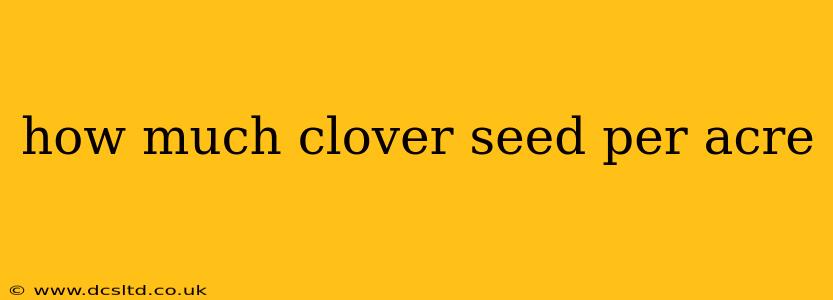Choosing the right clover seed rate per acre is crucial for establishing a thriving stand. Getting it wrong can lead to thin, patchy growth, reduced yields, and wasted resources. This guide will delve into the factors influencing seeding rates and help you determine the optimal amount for your specific needs.
What Factors Determine Clover Seed Rate Per Acre?
Several factors influence how much clover seed you should sow per acre. These include:
-
Clover Species: Different clover species have varying seed sizes and germination rates. For example, red clover seeds are larger than white clover seeds, requiring a different seeding rate. Alsike clover has its own unique needs as well.
-
Soil Conditions: Poor soil conditions, such as low fertility or compacted soil, necessitate a higher seeding rate to compensate for lower germination and establishment success. Well-drained, fertile soil generally requires less seed.
-
Method of Seeding: Broadcasting (scattering seed across the surface) typically requires a higher seeding rate than drilling (placing seed in rows). Drilling allows for more precise seed placement, leading to better germination and less seed wastage.
-
Intended Use: Are you establishing a pasture, cover crop, or a lawn? Pastures require denser stands than lawns, which need less clover. The intended use significantly impacts the ideal seeding rate.
-
Desired Stand Density: The desired density of the clover stand will influence the amount of seed needed. Higher densities require more seed, while lower densities require less.
How Much Clover Seed Per Acre for Different Species?
Providing a single number for clover seed per acre isn't sufficient. It varies greatly depending on the species and the factors mentioned above. However, we can offer some general guidelines. These are approximate and should be adjusted based on your specific circumstances. Always consult seed tag recommendations for the most accurate planting rates.
-
Red Clover: 8-12 lbs/acre for broadcast seeding, 6-8 lbs/acre for drilling.
-
White Clover: 1-3 lbs/acre for broadcast seeding, 0.5-1.5 lbs/acre for drilling. Micro clover varieties will have lower rates.
-
Alsike Clover: 4-6 lbs/acre for broadcast seeding, 3-4 lbs/acre for drilling.
What About Mixtures?
Many farmers and gardeners utilize clover seed mixes, combining different clover varieties or clover with other grasses or legumes. In these situations, the seeding rate for each species within the mix will need to be considered. The seed tag for the mix should provide recommended seeding rates.
What if My Clover Stand is Thin?
A thin clover stand might result from various issues:
- Insufficient Seeding Rate: Using too little seed is a common cause.
- Poor Soil Conditions: Compacted soil or low fertility can hinder germination.
- Pest or Disease Problems: Insects or diseases can damage seedlings.
- Competition from Weeds: Aggressive weeds can outcompete clover seedlings.
How to Ensure Successful Clover Establishment
Besides using the appropriate seeding rate, here are several critical practices to ensure a successful clover stand:
- Proper Soil Preparation: Ensure the soil is well-prepared and free of weeds.
- Appropriate Planting Time: Plant clover at the optimal time for your region and clover species.
- Adequate Moisture: Provide sufficient moisture for germination and establishment.
- Weed Control: Control weeds to minimize competition.
Remember, these are general guidelines. Always refer to your seed tag for species-specific recommendations and consider consulting with local agricultural extension services for advice tailored to your specific location and soil conditions.
Frequently Asked Questions (FAQ)
Can I overseed clover?
Yes, you can overseed clover, especially if your existing stand is thinning. The best time to overseed is typically in the fall or early spring. You'll need to adjust the seeding rate accordingly, usually planting at a lower rate than for a new stand.
What is the best time to plant clover?
The best time to plant clover varies depending on your location and the species. Generally, spring and fall are ideal times for planting, but specific recommendations should be based on your local climate.
How deep should I plant clover seed?
Clover seed is small and should be planted shallowly, ideally less than 1/4 inch deep. Deeper planting can hinder germination. For broadcast seeding, simply scatter the seeds and lightly rake them into the soil.
By considering these factors and following best practices, you can achieve a healthy and productive clover stand. Remember to always consult your seed tag for the most accurate planting guidelines for your specific clover variety.
